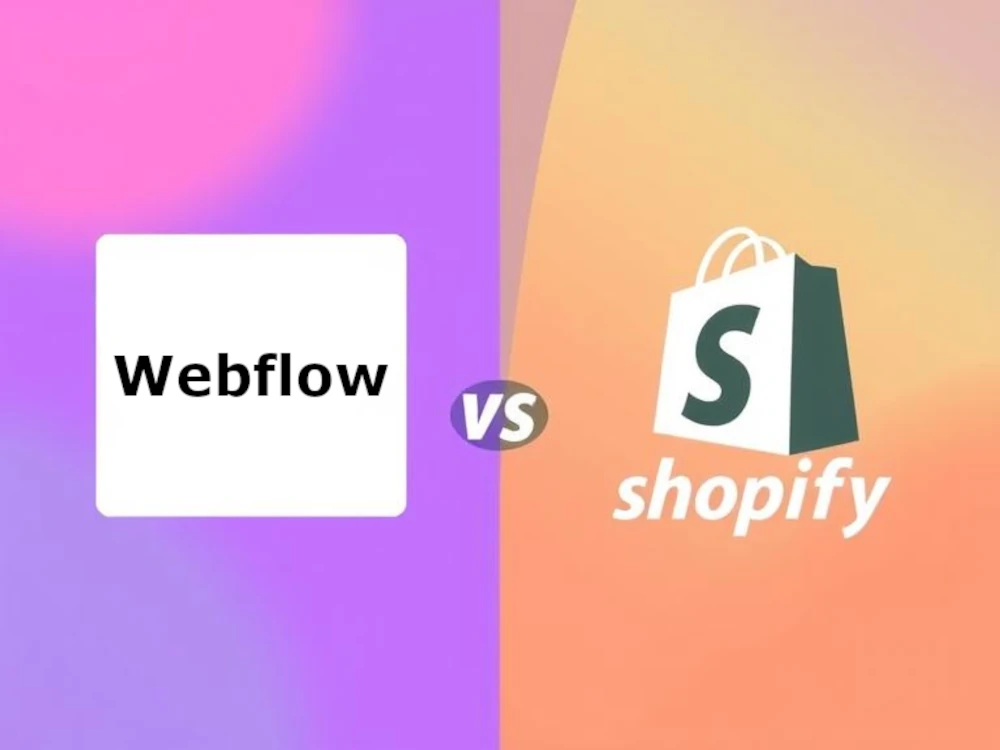With e-commerce expanding exponentially, more aspiring entrepreneurs are seeking robust yet accessible store-building solutions. Two leading options – Webflow and Shopify – each offer compelling benefits tailored for different users based on technical skills and business needs.
People often ask their e-commerce consultants for advice on deciding between these popular platforms. This is a really important issue that requires a long discussion, so we wrote this article to simplify your choice between platforms. Here’s an in-depth, side-by-side analysis highlighting key distinctions to inform decisions when assessing Webflow and Shopify.

User Experience (UX) Customization
For store owners prioritizing brand differentiation through unique, customized user experiences, Webflow services offer more advanced design flexibility.
Its drag-and-drop visual canvas allows extensive on-page layout manipulation for crafting truly personalized storefronts without coding. Dynamic content galleries, interactions and animations enhance navigation and storytelling.
Conversely, Shopify’s templated Foundation themes limit branding individuality for turnkey convenience. Users must heavily supplement through add-ons to recreate advanced post-click functions that Webflow builds natively. For businesses looking for the best Webflow development company, this platform is ideal for immersive patron engagement via interactive and animated browsing environments. Webflow better extends conventional e-commerce layouts if UX uniqueness holds value. However, Shopify offers satisfactory templates if visual conformity doesn’t hinder objectives.
So, for immersive patron engagement via interactive/animated browsing environments, Webflow better extends conventional e-commerce layouts if UX uniqueness holds value. However, Shopify offers satisfactory templates if visual conformity doesn’t hinder objectives.
SEO Optimization Capabilities
Customizing online visibility through search engine rankings proves crucial, so SEO-enhancing capabilities deserve comparison.
Out-of-the-box, Shopify automatically configures fundamental metadata, alt text, and performance practices for baseline SEO readiness. However, Webflow’s flexibility allows deeply optimized content structures, URLs, and faster-loading page assets to boost discoverability.
Additionally, Webflow adheres to semantic markup using structures like header tags, which search engines better interpret for secure rankings. However, Shopify’s themes often misuse generic div tags unless they are manually optimized per page.
Here is an overview of key SEO differentiation factors:
Webflow
- Semantic HTML markup
- Custom URL slug optimization
- Image/content compression
- XML site maps
- Lazy loading elements
- Quicker mobile load speeds
Shopify
- Auto-generated meta descriptions
- Alt-text configuration
- Built-in performance metrics
- Automatic HTTP/2 protocol
- CDN for caching assets
- Alt text automation apps
So, Webflow provides greater built-in conformance to SEO standards, whereas publishers relying on Shopify must augment with third-party tools for comparable discoverability.
Multiplatform Content Integration
Relative content management flexibility also holds significant implications for productivity.
Webflow only publishes templated content within its closed editor, forcing reliance on its proprietary CMS, which lacks output functionality. However, Shopify integrates with virtually all external CMS platforms. Users can conveniently manage product/inventory data externally while benefiting from Shopify’s retail tools.
Unless publishers and brands adopt Webflow ecosystem-wide, Shopify alleviates multiplying CMS friction through open composability. But, those without existing content systems may benefit more from learning one tool via Webflow’s consistency.
Ease of Core Checkout/Payment Integrations
As customer journeys reach climactic sale points, optimized transaction module functionality proves crucial for conversions.
Shopify offers a turnkey, elegantly designed checkout flow while handling all payment routing/processing intricacies by default. On the other hand, Webflow accepts payments via third-party integrations only.
So, site owners who want secured checkouts are burdened by additional vendor evaluation, risk analysis, and coordination. Consequently, Shopify substantially simplifies core payment infrastructure for sales tracking, reconciliation, and support.
Webflow publishers trade off control flexibility for procedural overhead unless they are maintaining checkout third parties already.
Relative Ongoing Cost & Support Implications
Important financial considerations around initial and recurring pricing warrant transparency when committing to either platform.
Shopify’s transparent tiered plans scale rates from $32/month based on revenue share terms. One-off site migration and easy launch of project budgets. However, custom-building Webflow sites require upfront quoting before variable ongoing fees, depending on support needs.
While both platforms offer 24/7 chat assistance, Shopify users often report quicker resolutions for time-sensitive issues like order defects. Webflow’s popularity hampers support responsiveness as its community grows.
Shopify simplifies budgeting while providing slightly more accessible urgent customer support. But highly customized Webflow sites justify higher investments for revenue capabilities tailoring warrants.


